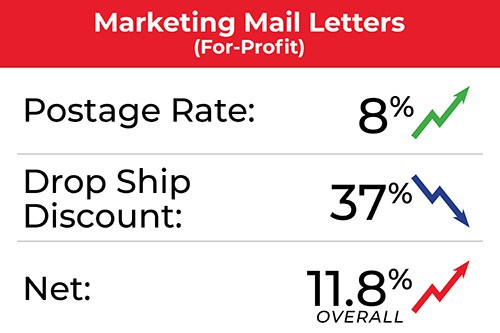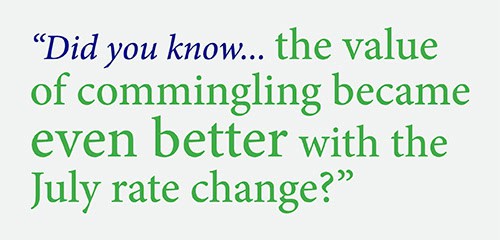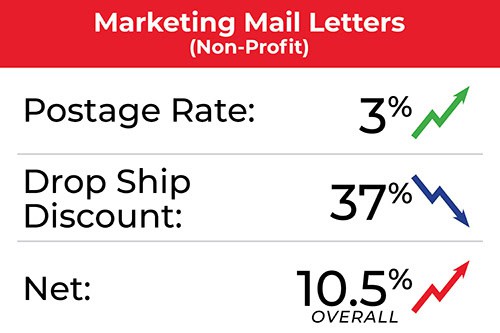Navigating a postage increase is not only about cost. It’s about keeping your campaigns effective and your timelines reliable, all within what you budgeted.
The July 13, 2025 postal rates change introduced new factors that go beyond the usual percentage increases, affecting mailers across formats and industries. Without a clear view of what’s really changed, even seasoned mailers risk making costly assumptions.
This article helps you make sense of the changes, so you can adapt with confidence, protect your ROI, and continue leading smart, high-performing direct mail programs.
The good news: understanding the full impact now puts you in control. This article breaks down the four most important changes, what they mean for you, and how to navigate them to stay competitive and cost-efficient. Plus, we’ll break down how all this impacts non-profit rates.
1. The real rate increase is higher than it appears.
On paper, you might have expected an average rate increase of 7.4% to 8.5%, as listed [PDF, 178.61 KB], depending on your mail class and product type (letter, flat, parcel) combination.
But if you’re relying on drop shipping for cost savings—as most high-volume mailers are—those numbers are misleading.
Here’s why:
- The USPS eliminated the NDC per-piece drop ship discount entirely.
- The USPS reduced the sCF per-piece drop ship discount by 37.5%

This means your actual postage increase could hit 11-12% or more, depending on your format (letter vs. flat) and non-profit status.
To achieve your best possible postage, your postal strategy must change to something that still nets savings by:
- Commingling to help mitigate the increase
- Entering the SCF directly in a way that yields positive ROI, for more in-home control
- Leveraging other postal savings opportunities to further mitigate the increase (promotions [PDF, 223.96 KB]/incentives)
What to do: The postage variables change with the July 2025 postal rates increase. Ask your mail service provider (MSP) for a clear view of your net postage value, including how commingling and entry strategies affect your bottom line.
It is more crucial than ever to evaluate if you are doing everything possible to reduce your total cost to mail (i.e., production plus postage). All direct mailers need an expert postal evaluation at this time due to these changes, so consider if you need a second opinion.
2. Commingling just became a necessity—even for skeptics.

We’ve seen long-time direct mailers begin to commingle as a result. The July changes shifted the balance.
New challenges that commingling can help overcome
Without NDC discounts, a large portion of mail is essentially becoming origin-entered mail—the most expensive and least predictable option. This shift reduces your control over in-home windows and introduces a 10-14 day delivery range, making it more difficult to budget with confidence.
Many mailers who previously avoided commingling are now seeing it as the best way to stabilize both costs and timing. In fact, the removal of the NDC discount means there are more pieces that can benefit from commingling. Even with the reduction of the SCF per-piece drop ship discount, you can still get a significant net savings.
We conducted a study to measure how the July 2025 rate change affects commingle savings. We looked at one-time mailings across 10 clients, where the mailings spanned the breadth of overall volume and percent commingled. This way, we ensured our study included a variety of gross savings rates. We concluded that the postage savings commingle creates increased an average of 14.6% after the July 13 postal rate change.

But it matters how your commingling is handled
Different commingling providers have different advantages and processes. Evaluate your case to ensure you gain a true net value. For one, you should not be paying for 100% of your volume to be commingled. Instead, it only makes sense to pay for the pieces that benefit from the process.
Another important factor to consider is whether your provider manages multiple commingle pools in-house or outsources commingling altogether. When your provider operates multiple commingle pools—like our three strategically scheduled pools—it gives you far greater flexibility to target in-home delivery windows that align with your ideal response timing. It also gives you more opportunities to test and optimize campaigns for performance. Fewer commingle options means fewer strategic levers, and less control when you need it most.
What to do:
Evaluate your provider’s process:
- Ask whether they only commingle the portion of your volume that delivers a net value, and whether they’ll show you how.
- What percentage of your mail consistently qualifies for 5-digit presort and SCF entry? If you are not achieving 96% of your total mail volume to 5-digit presort and 97%+ to SCF entry consistently, it would be in your best interest to check costs with another provider who has a better process.
- Determine what three commingle pools means for your marketing performance, and ask your provider what options they offer to control in-home dates.
3. Where you mail from matters more than ever.
At Freedom, to ensure we are in the best possible position to help our clients plan for budget certainty and cost mitigation, we actively engage with the USPS industry associations. In those association meetings, the USPS proposed zone-based pricing for origin-entered mail, to begin as early as January 2026. While that is yet to be finalized at the time of this article’s publication, this July 2025 postal rates change lays a bit of the groundwork in moving toward that.
Zone-based pricing is calculated based on the distance (measured by time to transport) from origin point to destination.
Here’s your strategic takeaway:
- Midwestern mail providers, especially those based in transportation hubs like Chicago, will have a cost advantage due to shorter distances and more competitive freight options.
- Regional mail providers with national mailings may see significant cost challenges.
What to do:
- If you are commingling at 97%, you are not dealing with origin mail. Your best bet is to commingle.
- If you have origin mail, consider the long-term implications of your mailing partner’s location. If you’re mailing nationally, choosing a centrally located mailing partner gives you a major advantage starting in 2026.
4. Promotions like Catalog Insights can soften the blow.
Beginning in October 2025, the USPS is launching a new Catalog Insights promotion that gives marketers 10% off postage on qualifying booklet-style letter mail. This isn’t just for retailers. If you’re a:
- Financial services provider showcasing one or more product lines
- Telecom company offering bundled services
- Educational institution promoting one or more programs
… you might qualify by mailing a booklet with 12+ bound pages.
What to do:
Look at your current mail formats and content. Could you redesign a mailer (or combine multiple) as a bound booklet to take advantage of the 10% discount?
What this means for non-profits
Non-profits aren’t exempt from the impact. In fact, they’re seeing increases of 10.5% or more, closer to the commercial rate impact than in years past.

Drop shipping changes impact non-profits the same as commercial rate mailers, even if you’ve relied on those discounts to stay efficient. While the postage rate increase is smaller for non-profits, the drop ship discount decrease has a greater impact. That is because the drop ship discount relative to overall postage is a larger percentage for non-profit mailers than for those under for-profit postage.
When it comes to commingling, the greatest benefit resulting from the July 2025 rate change goes to non-profits. Similar to the study I outline above, where Freedom set out to determine post-increase for-profit commingling value, we looked at five one-time non-profit mailings, where the mailings chosen spanned the breadth of overall volume and percent commingled. This way, we ensured our study included a variety of gross savings rates. We compared commingling savings of those mailings pre- and post-increase. With this data, we concluded an average increase in savings after the rate change of 16.0% for non-profit comminglers.
What to do:
Now more than ever, non-profits need expert strategy and innovative ROI planning before campaigns hit the mail.
- Don’t assume historical performance will hold. Re-run your postage models with current rates and explore new formats that can improve net value.
- Lean into commingling.
- Since USPS promotion savings net about half the value of for-profit rate savings due to non-profit rates being lower to begin with, strategize with your provider on how to leverage these for a positive ROI.
- Prior to October, watch for the USPS to finalize how it will apply Catalog Insights to non-profits.
It’s time to re-evaluate
Now that the latest postage increase has taken effect, your pre-July strategy may cost you more than it needs to.
You don’t have to navigate the 2025 postal rates changes alone. With the right partner, you can build a mailing strategy that performs under pressure.
Want help evaluating your mailing strategy?
Let’s find the lowest total cost for you to mail—without compromising results: